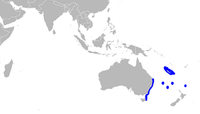Dumb gulper shark
| Dumb gulper shark | |
|---|---|
 | |
| Scientific classification | |
| Kingdom: | Animalia |
| Phylum: | Chordata |
| Class: | Chondrichthyes |
| Subclass: | Elasmobranchii |
| Order: | Squaliformes |
| Family: | Centrophoridae |
| Genus: | Centrophorus |
| Species: | C. harrissoni |
| Binomial name | |
| Centrophorus harrissoni McCulloch, 1915 | |
 | |
| Range of dumb gulper shark (in blue) | |
The dumb gulper shark, Centrophorus harrissoni, is a rare and endangered deepwater dogfish, known from only along the east coast of Australia and isolated spots north and west of New Zealand. It is also known as the dumb shark, Harrison's deep-sea dogfish, or Harrison's dogfish.[1]
Characteristics
The dumb gulper shark may grow to be 43 in (110 cm) long and has a long, robust head, a long, flattened snout, a large mouth, and large, green eyes, which help it see at 820 to 1260 ft (250 to 385 m) under water.[2][3] The body is slender and of moderate size, and is grey to greyish-brown in colour, with a paler underside. Of the two dorsal fins, the first is larger than the second, and each has a short spine, a white rear margin, and a dark blotch towards the front, which is more distinct in juveniles.[2] The large caudal fin is asymmetrical, with a longer upper than lower lobe.[3]
The broad teeth of this species differ between the upper and lower jaws, with the lower teeth being much larger. The teeth also differ between the male and female, with the male having much more erect, upright upper teeth, and upward-curving tips on the lowers.[2] The dumb gulper shark is very similar in appearance to the closely related little gulper shark.
Habitat
This shark is found off the east coast of Australia, New South Wales, Victoria, Queensland and Tasmania, and off New Zealand.[4][5] Its habitat is in the demersal zone on the upper to middle continental slope.
Behavior
These sharks eat mostly teleost fishes (particularly myctophids), cephalopods and crustaceans.[6] Females produce a maximum of one to two pups every one to two years. Evidence suggests that the left-side uterus is less functional than the right-side.[7] They can live up to 46 years on average.
Population
The population size is unknown, but numbers have decreased as much as 99% in some areas since the 1970s. This species is harvested, by commercial trawling or drop lining, for meat and liver oil (squalene). Upper-slope dogfish species are more vulnerable to capture than midslope species, because they are targeted throughout their vertical distribution and most of their local geographic distribution.[8] The low reproductive rate, late age of maturity, and long lifespan typical of these sharks means they are likely unable to recover quickly after depletion.
Conservation
Action is being taken to preserve the dumb gulper, which includes being incorporated into the Environmental Protection and Biodiversity Conservation (EPBC) Act to create a plan to keep this species safe. In response to this species’ inherent low productivity and continuing reduced numbers, managers have introduced landing restrictions and area closures to enhance C. harrissoni stocks in southern Australian waters.[7]
References
- 1 2 Pogonoski, J. & Pollard, D. (2003). "Centrophorus harrissoni". IUCN Red List of Threatened Species. Version 2011.2. International Union for Conservation of Nature. Retrieved 5 April 2012.
- 1 2 3 White, W.T., Ebert, D.A. and Compagno, L.J.V. (2008) Description of two new species of gulper sharks, genusCentrophorus (Chondrichthyes: Squaliformes: Centrophoridae) from Australia. In: Last, P.R., White, W.T. and Pogonoski, J.J. (Eds.) Descriptions of New Australian Chondrichthyans. CSIRO Marine and Atmospheric Research Paper No. 022, CSIRO, Australia.
- 1 2 Compagno, L.J.V. (1984). "Sharks of the World. An Annotated and Illustrated Catalogue of Shark Species Known to Date, Vol. 4: Part 1: Hexanchiformes to Lamniformes" (PDF). Rome: Food and Agriculture Organization of the United Nations.
- ↑ Scientists delighted to find rare shark off the east coast of Flinders Island, Tasmania
- ↑ Duffy, Clintoni A. J. (1 June 2007). "First record of Centrophorus harrissoni from New Zealand, with observations on squamation in centrophoridae (squaliformes)". New Zealand Journal of Marine and Freshwater Research. 41 (2): 163–173. doi:10.1080/00288330709509905.
- ↑ Daley, R., Stevens, J. and Graham, K. 2002. Catch analysis and productivity of the deepwater dogfish resource in southern Australia. Report by CSIRO Marine Research and NSW Fisheries to the Fisheries Research and Development Corporation. FRDC Project 1998/108.
- 1 2 Graham, K. J.; Daley, R. K. (1 January 2011). "Distribution, reproduction and population structure of three gulper sharks (Centrophorus, Centrophoridae) in south-east Australian waters". Marine and Freshwater Research. 62 (6): 583. doi:10.1071/MF10158.
- ↑ Andrew, N.L., Graham, K.J., Hodgson, K.E. and Gordon, G.N.G. 1997. Changes after twenty years in relative abundance and size composition of commercial fishes caught during fishery independent surveys on SEF trawl grounds. NSW Fisheries Final Report Series No. 1 FRDC Project No. 96/139.
External links
- ARKIVE Dumb gulper shark - Videos, photos and facts
